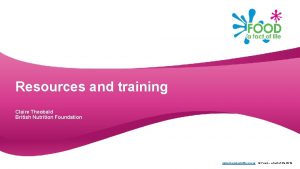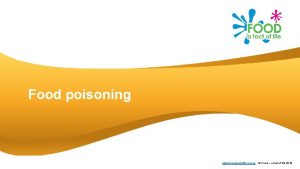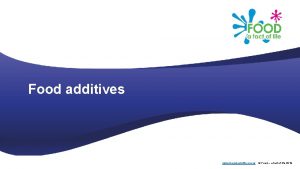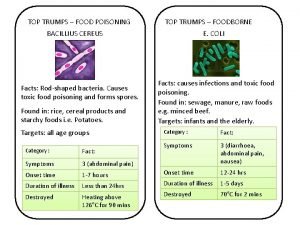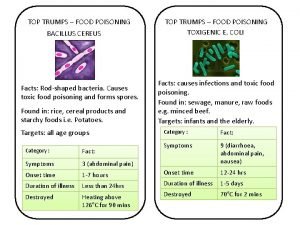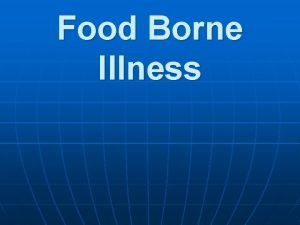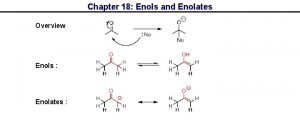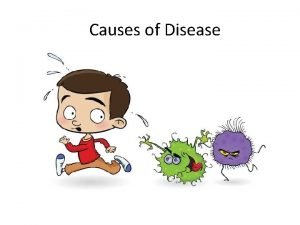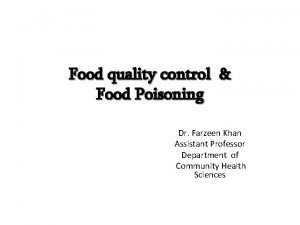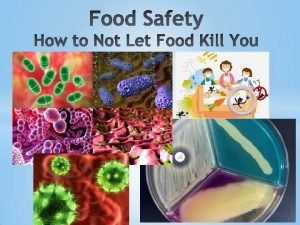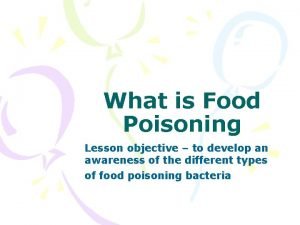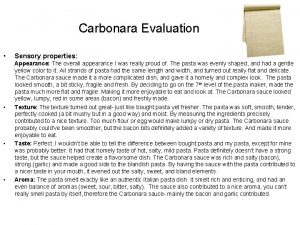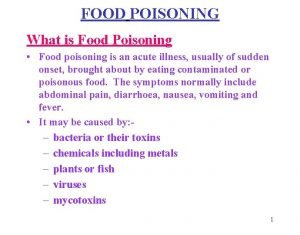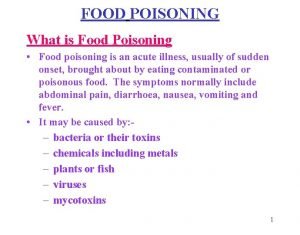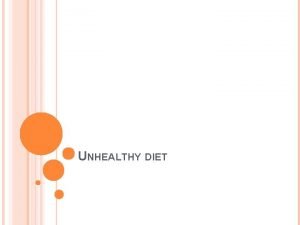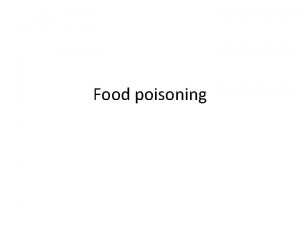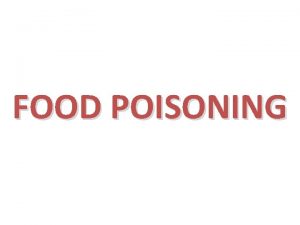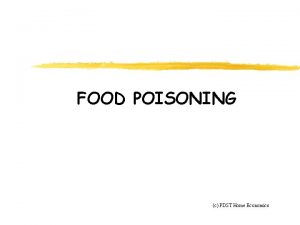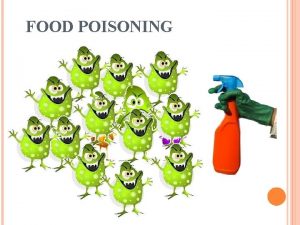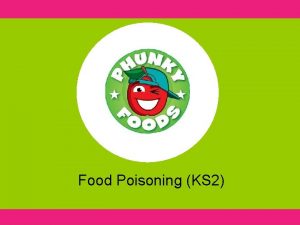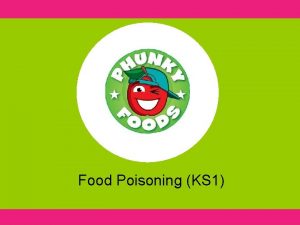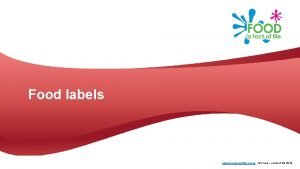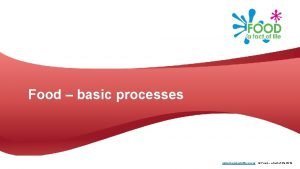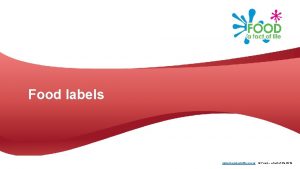Food poisoning www foodafactoflife org uk Food a























- Slides: 23

Food poisoning www. foodafactoflife. org. uk © Food – a fact of life 2019

Food poisoning An estimated one million people are affected by foodborne disease in the UK annually, costing the economy in excess of £ 1 bn. Laboratory confirmed human cases in the UK from 2000 to 2017 of the four major bacterial pathogens (harmful bacteria) are shown below. Only a minority of cases are reported and samples sent for analysis. Food standards Agency www. foodafactoflife. org. uk © Food – a fact of life 2019

Food poisoning may result from poor domestic food preparation, or poor food processing in industry including restaurants, cafes and take-aways. This may result in loss of business and people’s jobs if it is a serious outbreak. www. foodafactoflife. org. uk © Food – a fact of life 2019

Food poisoning Micro-organisms occur naturally in the environment, on cereals, vegetables, fruit, animals, people, water, soil and in the air. Most bacteria are harmless but a small number can cause illness. Food which is contaminated with food poisoning micro-organisms can look, taste and smell normal. www. foodafactoflife. org. uk © Food – a fact of life 2019

Food spoilage Changes in food, either through enzyme deterioration of food or micro-organism growth, will eventually lead to the food becoming inedible or unsafe if eaten. The rate of deterioration depends on a variety of factors which must be controlled carefully. Contaminants may be already present in the food, e. g. salmonella in chicken or transferred to the food by humans, flies, rodents and other pests. www. foodafactoflife. org. uk © Food – a fact of life 2019

High risk foods Some foods are high-risk, as they provide the ideal conditions needed for micro-organisms to grow. These include: • meat, meat products and poultry; • milk and dairy products; • eggs – uncooked and lightly cooked; • shellfish and seafood; • prepared salads and vegetables; • cooked rice and pasta Lion mark hen eggs can now be eaten raw or lightly cooked. Although people who have a severely weakened immune system and who are on a medically supervised diet prescribed by health professionals should cook all eggs thoroughly, even eggs that have the Red Lion stamp. If these foods become contaminated with food-poisoning microorganisms and conditions allow them to multiply, the risk of foodpoisoning increases. NHS advice www. foodafactoflife. org. uk © Food – a fact of life 2019

People at high risk Elderly people, babies and anyone who is ill or pregnant needs to be extra careful about the food they eat. For example, pregnant women or anyone with low resistance to infection should avoid high risk foods such as unpasteurised soft cheese. www. foodafactoflife. org. uk © Food – a fact of life 2019

Factors affecting food poisoning Some common factors leading to food poisoning include: • preparation of food too far in advance; • storage at ambient temperature; • inadequate cooling; • inadequate reheating; • under cooking; • inadequate thawing. www. foodafactoflife. org. uk © Food – a fact of life 2019

Factors affecting food poisoning Further common factors leading to food poisoning include: • consuming raw food; • improper warm holding (i. e. holding ‘hot’ food below 63ºC); • infected food handlers; • contaminated processed food; • poor hygiene. www. foodafactoflife. org. uk © Food – a fact of life 2019

Symptoms of food poisoning Food poisoning can be mild or severe. The symptoms will be different depending on what type of bacteria is responsible. Common symptoms include: • severe vomiting; • diarrhoea; • exhaustion; • headache; • fever; • abdominal pain; • tiredness. www. foodafactoflife. org. uk © Food – a fact of life 2019

Preventing food spoilage, contamination and poisoning Tips for buying food include: • it is illegal to sell food that has passed its ‘use by’ date; • dented, blown or rusted cans of food should not be purchased; • frozen food which has frozen together in the pack should not be purchased; • do not buy food where the packaging has been damaged; • only shop in clean and hygienic stores. www. foodafactoflife. org. uk © Food – a fact of life 2019

Preventing food spoilage, contamination and poisoning Tips for transporting food back home: • buy chilled and frozen foods at the end of the shopping trip; • keep frozen and chilled foods cold, by using cool boxes/bags and packing these types of foods together; • cooked and uncooked foods should be kept separate; • dry and moist foods should be packed separately; • household chemicals should be packed separately. www. foodafactoflife. org. uk © Food – a fact of life 2019

Preventing food spoilage, contamination and poisoning Tips for storing food in the home: • food should be unpacked as soon as possible; • old stocks of food should be used before buying new ones (first in, first out theory); • store food in the correct place, i. e. dry food, in cool, dry clean places and chilled food in the refrigerator. www. foodafactoflife. org. uk © Food – a fact of life 2019

Bacteria - Clostridium botulinum Sources Fish and meat. Dust, soil and vegetables. Inadequately processed canned meat, vegetables and fish (faulty canning). Signs and symptoms Onset 12 -36 hours. Voice change, double vision, drooping eyelids, severe constipation. Death within a week or a slow recovery over months. www. foodafactoflife. org. uk © Food – a fact of life 2019

Bacteria – Campylobacter Sources Raw and undercooked poultry, unpasteurized milk, contaminated water. Signs and symptoms Onset 2 – 5 days (can be longer). Fever, headache and dizziness for a few hours, followed by abdominal pain. This usually lasts 2 – 7 days and can recur over a number of weeks. www. foodafactoflife. org. uk © Food – a fact of life 2019

Bacteria - Clostridium perfringens Sources Animal and human waste. Dust, soil and vegetables. Raw meat. Insects. Signs and symptoms Onset 12 -18 hours. Abdominal pain, diarrhoea and nausea. This usually lasts 12 – 48 hours. Clostridium perfringens forms spores. www. foodafactoflife. org. uk © Food – a fact of life 2019

Bacteria - E Coli 0157 Sources Raw and undercooked meat and poultry. Unwashed vegetables. Contaminated water. Signs and symptoms Onset usually 3 -4 days. Diarrhoea, which may contain blood, can lead to kidney failure or death. www. foodafactoflife. org. uk © Food – a fact of life 2019

Bacteria – Salmonella Sources Raw meat, poultry and eggs. Flies, people, sewage and contaminated water. Signs and symptoms Onset 6 -48 hours. Headache, general aching of limbs, abdominal pain and diarrhoea, vomiting and fever. This usually lasts 1 – 7 days, and rarely is fatal. www. foodafactoflife. org. uk © Food – a fact of life 2019

Bacteria - Staphylococcus aureus Sources Humans: nose, mouth and skin. Untreated milk. Signs and symptoms Onset 1 – 6 hours. Severe vomiting, abdominal pain, weakness and lower than normal temperature. This usually lasts 6 – 24 hours. www. foodafactoflife. org. uk © Food – a fact of life 2019

Bacteria – Listeria Sources Unpasteurised milk and dairy products, cook-chill foods, pate, meat, poultry and salad vegetables. Signs and symptoms Onset 1 -70 days. Ranges from mild, flu-like illness to meningitis, septicaemia, pneumonia. During pregnancy may lead to miscarriage or birth of an infected baby. www. foodafactoflife. org. uk © Food – a fact of life 2019

Bacteria - Bacillus cereus Sources Rice and cereals. Dust, soil and vegetables. Signs and symptoms Ranges nausea and vomiting and abdominal cramps and has an incubation period of 1 to 6 hours. This usually lasts less than 24 hours after onset. Bacillus cereus forms spores and releases toxins which cause illness. www. foodafactoflife. org. uk © Food – a fact of life 2019

To reduce the risk of food poisoning, follow these simples rules: • Always follow ‘use by’ dates; • Store food correctly, either cold or hot, never warm; • Separate raw and cooked food; • Wash fruits and vegetables; • Thoroughly cook food; • Keep yourself and your workspace clean; • Don’t cough or sneeze over food; • Thoroughly wash and dry hands regularly. www. foodafactoflife. org. uk © Food – a fact of life 2019

Food poisoning For further information, go to: www. foodafactoflife. org. uk © Food – a fact of life 2019
 Www.foodafactoflife.org.uk
Www.foodafactoflife.org.uk Bnf explore food
Bnf explore food Symptoms of food poisoning
Symptoms of food poisoning Www.foodafactoflife.org.uk
Www.foodafactoflife.org.uk Food a fact
Food a fact Www.foodafactoflife.org.uk
Www.foodafactoflife.org.uk Foodafactoflife
Foodafactoflife Www.foodafactoflife.org.uk
Www.foodafactoflife.org.uk Foodafactoflife
Foodafactoflife Food top trumps
Food top trumps B. cereus food poisoning
B. cereus food poisoning Icd 10 fraktur pergelangan tangan
Icd 10 fraktur pergelangan tangan Gastroenterritis
Gastroenterritis Food poisoning cause
Food poisoning cause Giardia causes what disease
Giardia causes what disease Common factors that can lead to food poisoning
Common factors that can lead to food poisoning Food poisoning
Food poisoning Food poisoning or hangover
Food poisoning or hangover Lesson plan on food poisoning
Lesson plan on food poisoning Emanuela carbonara
Emanuela carbonara Recipe modification
Recipe modification Food fact of life costing
Food fact of life costing Foodafactoflife
Foodafactoflife Www.foodafactoflife
Www.foodafactoflife

